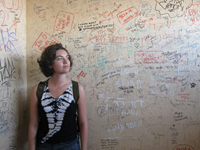A False Dichotomy: Rachel Lallouz
in Conversation with Matt Rader

Malahat marketing assistant Rachel Lallouz talks with Matt Rader, winner of the 2014 Jack Hodgins Founders' Award for Fiction. Rader won this year's award for his short story "All This Was a Long Time Ago," which appeared in Issue 184, Fall 2013.
In “All This Was a Long Time Ago,” you delve deeply into the psychology of James Joyce. What drew you to write so confidently about such a famous figure? How much research was necessary “to do him justice”?
Joyce asserted himself as a character. His historical identity provided the details to leverage my imagination. I researched enough to create historical verisimilitude, but the real goal was just to imagine the story more fully. I was careful to call this fiction. This story is not, and is not meant to be, historically accurate, nor is it a memoir.
To some readers this story may read less like fiction and more like creative nonfiction or even as a biographical essay about Joyce. How they come to read who the narrator is, as a character and a memoirist, determines how they read the story itself. What are your objectives in playing around with genre, character, and voice here?
I am interested in how certain rhetorical approaches signal different kinds of relationships to “fiction” or “nonfiction.” The rhetoric of essay, reportage, and memoir all offered me ways to access parts of my imagination. The signals of genre allowed me to bring several things I’d been thinking about together. My objective was to write something I found interesting. I’m very pleased that at least the editorial board of The Malahat Review and Michael Crummey also found it interesting.
Fruit, with its implications of immediate pleasure, seems to play a quiet, important role in this story. What does “fruit” represent to you as a symbol, and to what extent does this symbol help carry the “work” of the narrative?
That’s a question I feel is better answered by readers than writers. Or at least better answered by readers of this story than the writer of this story. What I can say is that one of the ways I proceed through a composition is to look back at what I’ve already included and then include synecdochal and metonymic repetitions. By doing this, I try to create a kind of echo chamber that encourages readers to listen for unspoken words that can make meaning.
For me, the heart of the story lies in the narrator’s statement that “tonight, all the faces of the dead are in the window. I’m in the window.” Can you comment on what this means to your narrator?
Yes, this is the heart of the story for me as well. The climax. The narrator is in a liminal state both figuratively and literally. He’s on a boat between two places. He’s alive and not.
Michael Crummey, this year’s judge for the Jack Hodgins Founders’ Award for Fiction, notes that “the insights into love and desire, into the ways in which art and life intersect without ever becoming one in the same, are uncontrived and compelling.” Can you elaborate on the relationship between art and life in “All This Was a Long Time Ago”?
It is a huge honour to have my story selected by Michael Crummey. I am a longtime fan of his. Also, I think there is something to the idea that Crummey and I are both island boys, as is Jack Hodgins. Hodgins and I share the same valley of origin on Vancouver Island. I am doubly honoured to have my name attached to Jack Hodgins. He is the writer of record where I am from. There’s something in this set of relationships that feels like art.
I find the distinction between art and life to be a difficult one to discuss. My hunch is that these two terms stand in for attitudes toward artifice and authenticity rather than for some real distinction between what we make and how we live, because, as Ai Weiwei says, “everything is art.” In other words, a large part of me feels like it is a false dichotomy. Art is an experience of our lives. We don’t die when we go into galleries or read books. In fact, we often feel even more alive in the presence of art. My story is interested in the presence of the dead as a real part of our lives.

Rachel Lallouz
* * * * * * * *









